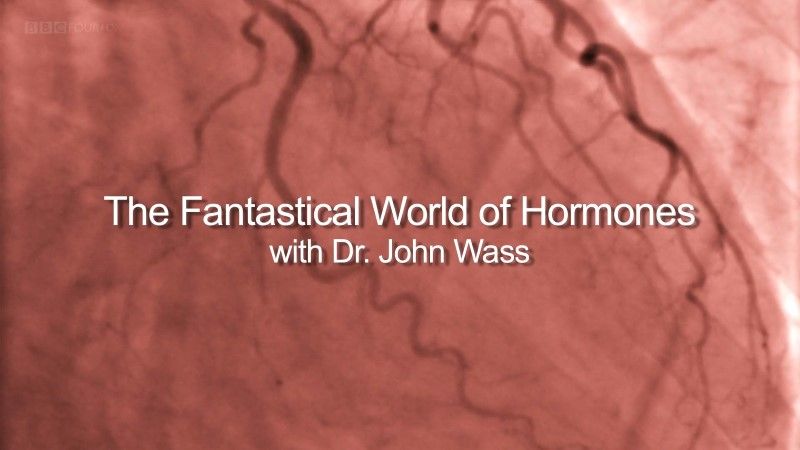The Fantastical World of Hormones: This documentary tells the wonderful and often weird story of how hormones were discovered.
Hormones shape each and every one of us, affecting almost every aspect of our lives – our height, our weight, our appetites, how we grow and reproduce, and even how we behave and feel.
Presenter John Wass, one the country’s leading experts on hormones, relates some amazing stories – how as recently as the 19th century boys were castrated to keep their pure soprano voice, how juices were extracted from testicles in the hope they would rejuvenate old men and how true medical heroes like Frederick Banting discovered a way to make insulin, thus saving the lives of countless diabetes sufferers.
And hormones remain at the cutting edge of medicine as we try and deal with modern scourges like obesity.
The Fantastical World of Hormones
A hormone (from the Greek participle ὁρμῶν, “setting in motion”) is any member of a class of signaling molecules, produced by glands in multicellular organisms, that are transported by the circulatory system to target distant organs to regulate physiology and behavior.
The glands that secrete hormones comprise the endocrine signaling system. The term “hormone” is sometimes extended to include chemicals produced by cells that affect the same cell (autocrine or intracrine signaling) or nearby cells (paracrine signalling).
Hormones serve to communicate between organs and tissues for physiological regulation and behavioral activities such as digestion, metabolism, respiration, tissue function, sensory perception, sleep, excretion, lactation, stress induction, growth and development, movement, reproduction, and mood manipulation. Hormones affect distant cells by binding to specific receptor proteins in the target cell, resulting in a change in cell function.
When a hormone binds to the receptor, it results in the activation of a signal transduction pathway that typically activates gene transcription, resulting in increased expression of target proteins; non-genomic effects are more rapid, and can be synergistic with genomic effects. Amino acid–based hormones (amines and peptide or protein hormones) are water-soluble and act on the surface of target cells via second messengers; steroid hormones, being lipid-soluble, move through the plasma membranes of target cells (both cytoplasmic and nuclear) to act within their nuclei.
Frederick Banting
Sir Frederick Grant Banting was a Canadian medical scientist, physician, painter, and Nobel laureate noted as the co-discoverer of insulin and its therapeutic potential.
In 1923, Banting and John James Rickard Macleod received the Nobel Prize in Medicine. Banting shared the honours and award money with his colleague, Charles Best. As of November 2018, Banting, who received the Nobel Prize at age 32, remains the youngest Nobel laureate in the area of Physiology/Medicine. That same year, the Government of Canada granted Banting a lifetime annuity to continue his work. In 1934, he was knighted by King George V.
Frederick Banting was born on November 14, 1891, in a farm house near Alliston, Ontario The youngest of five children of William Thompson Banting and Margaret Grant, he attended public high school in Alliston. In 1910, he started at Victoria College, part of the University of Toronto, in the General Arts program. After failing his first year, he petitioned to join the medical program in 1912 and was accepted. He began medical school in September 1912.
Insulin
Insulin is a peptide hormone produced by beta cells of the pancreatic islets; it is considered to be the main anabolic hormone of the body. It regulates the metabolism of carbohydrates, fats and protein by promoting the absorption of glucose from the blood into liver, fat and skeletal muscle cells. In these tissues the absorbed glucose is converted into either glycogen via glycogenesis or fats (triglycerides) via lipogenesis, or, in the case of the liver, into both.
Glucose production and secretion by the liver is strongly inhibited by high concentrations of insulin in the blood. Circulating insulin also affects the synthesis of proteins in a wide variety of tissues. It is therefore an anabolic hormone, promoting the conversion of small molecules in the blood into large molecules inside the cells. Low insulin levels in the blood have the opposite effect by promoting widespread catabolism, especially of reserve body fat.
Beta cells are sensitive to blood sugar levels so that they secrete insulin into the blood in response to high level of glucose; and inhibit secretion of insulin when glucose levels are low. Insulin enhances glucose uptake and metabolism in the cells, thereby reducing blood sugar level. Their neighboring alpha cells, by taking their cues from the beta cells, secrete glucagon into the blood in the opposite manner: increased secretion when blood glucose is low, and decreased secretion when glucose concentrations are high. Glucagon increases blood glucose level by stimulating glycogenolysis and gluconeogenesis in the liver. The secretion of insulin and glucagon into the blood in response to the blood glucose concentration is the primary mechanism of glucose homeostasis.
Obesity
Obesity is a medical condition in which excess body fat has accumulated to an extent that it may have a negative effect on health. People are generally considered obese when their body mass index (BMI), a measurement obtained by dividing a person’s weight by the square of the person’s height—despite known allometric inaccuracies — is over 30 kg/m2; the range 25–30 kg/m2 is defined as overweight. Some East Asian countries use lower values.
Obesity is correlated with various diseases and conditions, particularly cardiovascular diseases, type 2 diabetes, obstructive sleep apnea, certain types of cancer, and osteoarthritis. High BMI is a marker of risk, but not proven to be a direct cause, for diseases caused by diet, physical activity, and environmental factors. A reciprocal link has been found between obesity and depression, with obesity increasing the risk of clinical depression and also depression leading to a higher chance of developing obesity.
